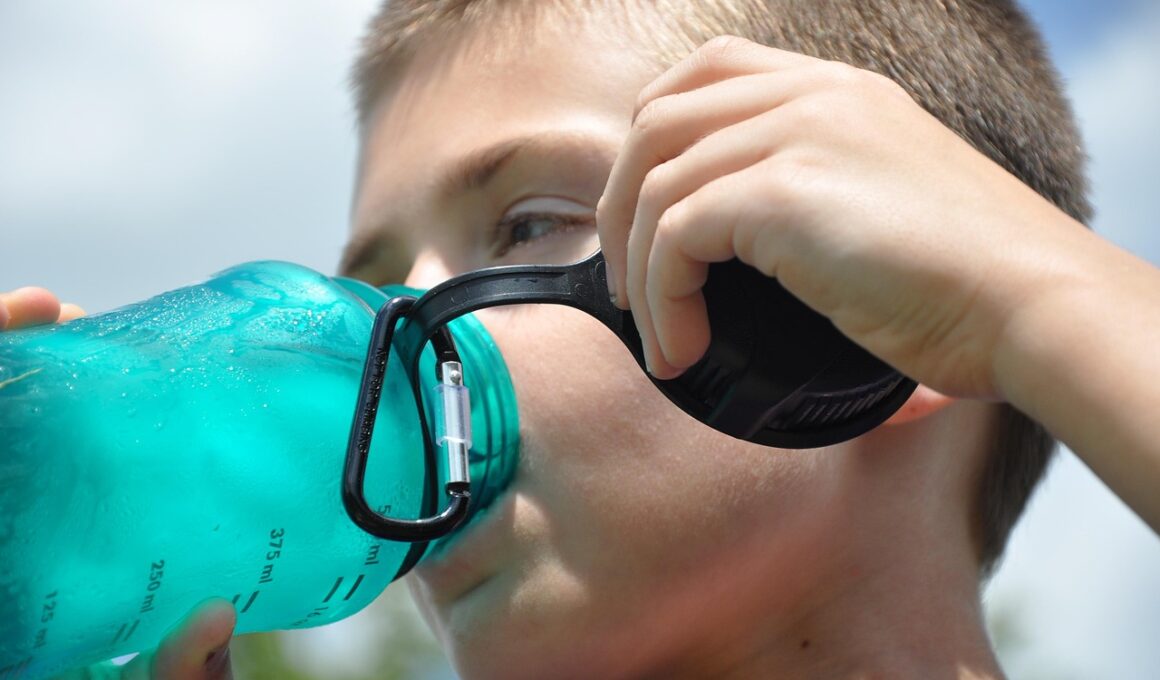Essential Hydration Tips for Beginner Swimmers
Swimming is an exhilarating way to stay fit, but beginners often overlook the importance of hydration during their swimming sessions. Proper hydration is crucial for enhancing performance, preventing fatigue, and improving overall enjoyment in the water. As a beginner swimmer, you may not realize that your body loses fluid through sweat, even while submerged. Thus, it’s essential to establish a hydration routine to replenish lost fluids. Always drink water before diving into the pool; it helps prepare your body and maintain hydration levels. It’s also beneficial to hydrate during your breaks between laps. Keep a water bottle close at hand, and take sips regularly, roughly every 15 minutes if you’re swimming continuously. Additionally, consider electrolyte drinks if you’re engaging in extended sessions to replenish essential minerals lost through sweat. Monitor your body’s signals as well; if you feel thirsty or fatigued, it’s a sign to hydrate. Remember, swimming should be fun, and proper hydration will boost your stamina and enhance your swimming experience.
As you strive to improve your swimming skills, understanding when and how much to hydrate can be pivotal. Even mild dehydration can cause performance setbacks or discomfort during your swim. Ideally, you should start hydrating before your swimming workout. Consume approximately 16 to 20 ounces of water at least two hours before entering the pool, which prepares your body for the activity ahead. Remember to hydrate throughout your swim. If you find yourself swimming for longer than 30 minutes, consider taking a brief moment to sip water after every lap or at designated intervals. This will ensure that you maintain an adequate fluid balance, enabling you to swim longer and feel energized. After your training session, recovering fluids is equally important. Aim to drink 16 to 24 ounces of water or an electrolyte beverage within the first hour after you finish swimming. Doing this will help restore fluid loss and maintain optimal hydration levels in your body. Additionally, incorporating fruits and foods high in water content into your diet can help maintain overall hydration.
Recognizing Signs of Dehydration
Recognizing the signs of dehydration is essential for beginner swimmers who may not be aware of how their body reacts to fluid loss. Symptoms can range from mild to severe, but early detection can significantly improve your swimming experience. For instance, if you begin to feel dizzy, excessively tired, or notice a dry mouth, these symptoms may indicate dehydration. More severe signs could include headaches, dark-colored urine, or a rapid heart rate. When swimming, you might also experience reduced coordination or muscle cramps, signaling that your body is not adequately hydrated. Before your next swim, check in with how you feel. If you experience any of these symptoms, prioritize hydration by consuming water or an electrolyte drink to reverse the dehydration. Additionally, if you know you’re likely to be swimming intensively, consider pre-hydrating or having a hydration plan. It’s essential to listen to your body to ensure that hydration becomes a part of your swimming routine. By being proactive, you can enjoy every swim while minimizing the risk of dehydration-related issues.
Another key factor in hydration for beginner swimmers is understanding individual needs. Each swimmer may have different hydration requirements based on various factors including body size, intensity of swimming, and even environmental conditions such as temperature and humidity. Therefore, instead of adhering to a one-size-fits-all hydration plan, it’s beneficial to experiment with your fluid intake to discover what works for you. Begin with general guidelines; for instance, drinking around half your body weight in ounces daily could be a good target. Gradually adjust based on your activity level and how your body responds. If you sweat more, increase your water intake, particularly on hot days. To track your hydration progress, you might maintain a journal to log your daily fluid consumption. Additionally, pay attention to how your body feels during swims. Are you more energized when properly hydrated or do you sense fatigue? These observations can guide you in optimizing your hydration strategy for better swimming performance and enjoyment.
Hydration-Friendly Snacks
Incorporating hydrating snacks into your routine can additionally boost your fluid intake, especially if you are swimming regularly. Many fruits and vegetables contain high levels of water, providing hydration alongside essential vitamins and nutrients. For example, watermelon, cucumbers, and oranges are fantastic options as they are composed of over 90% water. Before or after your swim, snacking on these foods can help increase your hydration levels while providing an energy boost. Besides fruits and vegetables, consider consuming yogurt or smoothies, both of which are delicious, refreshing, and hydrating. These nutritious options can also be easily digested, making them suitable for consumption before swimming sessions. Always keep a stash of these hydration-friendly snacks available, particularly on days when you plan to swim for a longer duration. Furthermore, try to find simple recipes that include hydrating ingredients to ensure that you are refueling your body effectively. Remember that snacks are not merely about filling your stomach; they should also be about supporting your hydration for optimal swimming experiences.
Many beginner swimmers might overlook the impact of temperature on hydration. Water temperatures can affect how your body loses fluids during a swim session. For instance, swimming in warmer water will likely cause you to sweat more than in cooler water. Therefore, it’s vital to adjust your hydration strategy according to the temperature of the water. Ideally, you should increase your intake on warm days and monitor how long you spend in the pool. If you feel sticky or unusually tired while swimming in warmer waters, it’s a clear indicator that you need to hydrate more. In contrast, during colder swimming sessions, hydration may take a back seat, leading to dehydration without obvious signs. Thus, pay attention to your body and develop an awareness of varying hydration needs depending on the water temperature. Make it a habit to drink water even if you don’t feel thirsty, as a proactive approach will always be beneficial regardless of swimming conditions. Staying hydrated keeps you swimming strong and makes your experience more enjoyable.
Creating a Hydration Schedule
To ensure you remain properly hydrated, establishing a hydration schedule can be immensely helpful for beginner swimmers. This structured approach can guide you in staying consistent with your fluid intake throughout your training and daily life. Start by setting specific times for drinking water, such as upon waking up, before meals, and during or after each swim. Incorporate reminders on your phone or create a hydration log to track your water consumption. Breaking your daily intake into smaller, manageable portions can make it easier to meet your hydration goals. For instance, aim for a glass of water during each hour, which can significantly add up throughout the day without feeling overwhelming. During post-swim recovery, have a designated drink waiting for you at the poolside to remind you to hydrate. Additionally, remember to adapt your schedule based on weather conditions and workout intensity. By creating a practical hydration schedule, you ensure that you remain proactive about your body’s hydration needs, ultimately enhancing your swimming enjoyment and performance.
Lastly, it’s crucial to remind beginner swimmers that staying hydrated isn’t confined to just drinking water. Variation is the key to keeping your hydration enjoyable and effective. Incorporate a mix of flavors in your hydration plan, such as herbal teas, flavored water, or coconut water, as they can add excitement to your hydrating experience. Experiment with recipes for refreshing hydration drinks that you can prepare at home, utilizing natural ingredients like fruits and herbs. For instance, infuse your water with mint or lemon for a refreshing taste. Hydration shouldn’t feel like a chore; it can be a delightful experience when you find flavors that appeal to you. Additionally, pay attention to your body’s responses to various drinks. Do you prefer plain water, or do you enjoy the taste of coconut water after an intense swim? Being mindful of your preferences can help create a hydration strategy that works best for you while ensuring that you stay on track. Ultimately, hydration is about ensuring you enjoy swimming to the fullest, enhancing not just performance but overall well-being.


